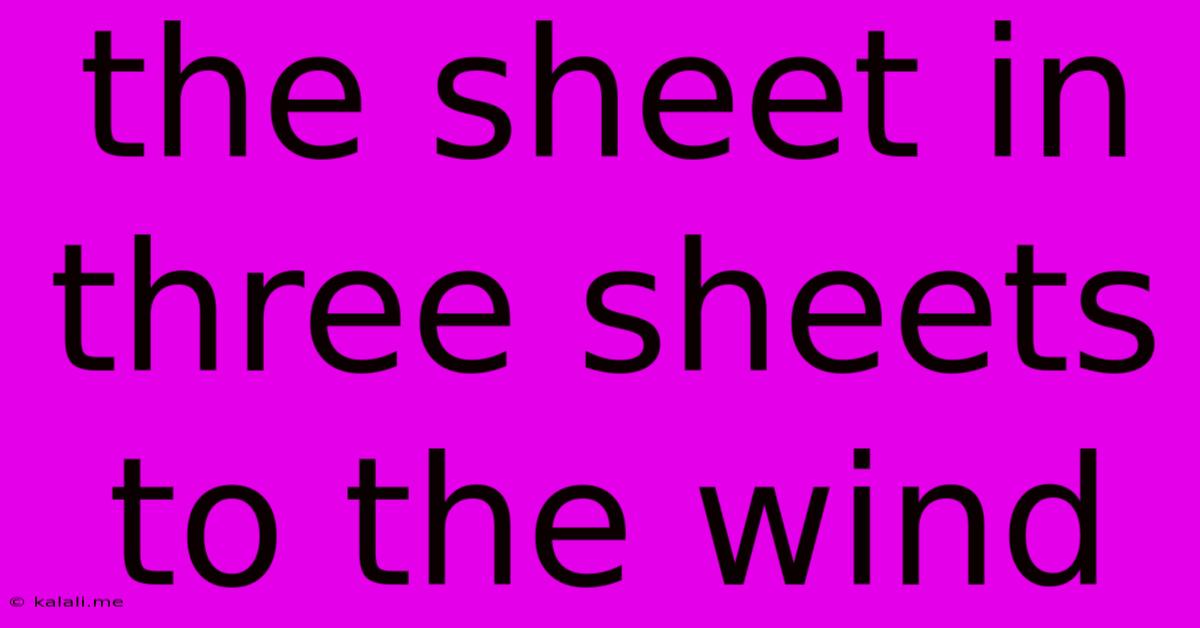The Sheet In Three Sheets To The Wind
Kalali
Jun 03, 2025 · 2 min read

Table of Contents
Three Sheets to the Wind: Understanding the Idiom and Its Nautical Origins
The idiom "three sheets to the wind" paints a vivid picture of someone thoroughly intoxicated. But where did this colorful expression come from? Understanding its nautical roots reveals a surprisingly literal meaning, which adds depth and intrigue to its modern usage. This article will explore the history, meaning, and modern applications of this enduring idiom.
What Does "Three Sheets to the Wind" Mean?
Today, "three sheets to the wind" is widely understood to mean severely drunk or intoxicated. Someone in this state is likely unsteady on their feet, exhibiting slurred speech, and demonstrating impaired judgment. The image conjured is one of uncontrolled movement and a lack of equilibrium.
Unraveling the Nautical Roots
To truly appreciate the idiom's meaning, we need to delve into its origins in sailing. On a sailing ship, "sheets" are the ropes used to control the sails. Each sail typically has multiple sheets. If these sheets are left loose or "uncontrolled," the sails will flap wildly in the wind, making the ship difficult to steer and potentially dangerous. "Three sheets to the wind" literally described a ship with its sails so unmanaged that it was completely out of control, tossed about by the wind. This chaotic state perfectly mirrors the uncontrolled behavior of someone heavily intoxicated.
The Evolution of the Idiom
The transition from a description of a ship to a description of a drunk person happened gradually. The image of a ship wildly flailing in the wind, completely at the mercy of the elements, is a strong metaphor for the loss of control experienced by someone under the influence of alcohol. This evocative imagery made the phrase catchy and memorable, leading to its widespread adoption beyond the nautical world.
Modern Usage and Variations
While the core meaning remains consistent – extreme intoxication – the idiom's usage has become more flexible. It's often used informally and humorously, sometimes exaggerating the degree of drunkenness for comedic effect. You might hear someone say, "He was three sheets to the wind after that party!" The emphasis is on the uncontrolled and unpredictable nature of the person's behavior, not necessarily a precise measurement of blood alcohol content.
Synonyms and Similar Idioms
While "three sheets to the wind" is unique in its imagery, many other idioms convey a similar meaning:
- Hammered: Suggests a severe level of intoxication.
- Smashed: Similar to hammered, emphasizing a state of extreme inebriation.
- Plastered: Implies being heavily intoxicated and possibly disoriented.
- Drunk as a skunk: A more informal and less formal idiom.
Conclusion:
The idiom "three sheets to the wind" offers a fascinating glimpse into nautical history. Its evocative imagery and enduring popularity highlight the power of language to capture complex ideas and experiences in a memorable and easily understandable way. Understanding its origins not only adds richness to your vocabulary but also provides a deeper appreciation for the colorful language that has emerged from maritime traditions.
Latest Posts
Latest Posts
-
Can Sram Groupset Use Shimano Crankset
Jun 05, 2025
-
What Can I Use To Substitute For A Coffee Filter
Jun 05, 2025
-
Fastest Way To Unlock Characters In Smash Ultimate
Jun 05, 2025
-
How To Search Telephone Numbers On Facebook
Jun 05, 2025
-
High Pressure On Low Side Of Ac System
Jun 05, 2025
Related Post
Thank you for visiting our website which covers about The Sheet In Three Sheets To The Wind . We hope the information provided has been useful to you. Feel free to contact us if you have any questions or need further assistance. See you next time and don't miss to bookmark.